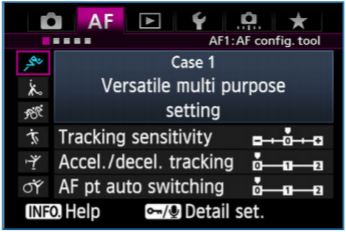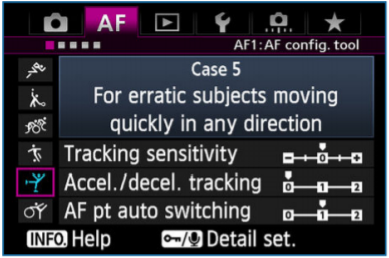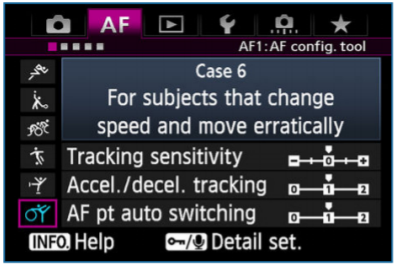QuickGuide to AI Servo Mode Autofocus Tracking
| Article ID: ART170170 | | | Date published: 04/30/2018 | | | Date last updated: 04/30/2018 |
Description
QuickGuide to AI Servo Mode Autofocus Tracking
Solution
INTRODUCTION
Canon EOS EOS-1D X and 5D Mark III cameras allow you to adjust continuous autofocus for all variations and combinations of three-dimensional subject motion: forward, backward, and from side-to-side. They also allows you to adjust for two different types of motion: smooth and predictable, or sudden and erratic.
These settings are most valuable when shooting moving subjects in AI Servo Mode, particularly situations where the subject is moving so quickly that automatic focus and focus point selection is the only reliable way to get a high ratio of correctly focused images. If you primarily photograph motionless subjects or are shooting video (which uses a different AF system) you may never need to adjust any of the following settings.
You have two basic choices for subject tracking in AI Servo AF:
AF POINT OPTIONS
Single-point/Spot AF With this option you choose one of the 61 available AF points for subject tracking. Spot AF narrows the size of the AF point to focus on small areas of a subject or scene. Keep in mind, however, that it may be difficult to track a subject that is moving rapidly.
AF Point Expansion/Surround
With this option the camera must first achieve focus with the primary AF point located in the center of a 4-point (expansion) or 8-point (surround) cluster. The camera will then use the outer points as necessary to maintain focus on a moving subject. For many shooters this is the ideal compromise between the narrow angle of Single-point/Spot AF and the wide coverage of Zone AF.
Zone AF
This option expands the number of active AF points to 9 or 12 points in a 3x3 or 3x4 grid. All AF points within the Zone are active. Having a larger AF zone makes it easier to keep a moving subject within the AF system’s field of view. One possible drawback is that because Zone AF always focuses on the nearest object, maintaining focus on a single subject may be more difficult than with a smaller AF area, especially if the subject is small in proportion to the frame and there are other, larger objects in front of it.
AF MENU OPTIONS
Menu AF1
AF Configuration Tool – This menu has six “Cases” that provide various preset configurations of three basic parameters: tracking sensitivity, subject motion (steady vs. erratic), and AF point automatic switching—how quickly the AF system will shift AF points while tracking a moving subject. Note: AF point automatic switching is available only when the camera is set to one of the three area AF modes (61-point automatic selection AF, Zone AF, and AF point expansion area). It is not available when the camera is set to Single-Point or Spot AF.
Menu AF2
AI Servo 1st/2nd image priority – Decide whether you want the fastest possible shutter firing, or prefer to insure the sharpest focus, even if that means a slight delay in firing. Separate menu options let you control this for initial shot in a sequence, and for second and all subsequent shots in a sequence.
Menu AF3
One Shot AF release priority – This option controls whether the camera will prioritize the fastest possible shutter release or correct focus when the camera is focusing on stationary subjects in One-Shot AF mode. There are also settings for controlling lenses with electronic M-focus feature, and whether to enable or disable the AF-assist beam feature on an attached Speedlite.
Menu AF4
AF Point Selection – This option controls which points you can select and how. It also controls whether or not a lens will continually attempt to focus even if AF proves impossible.
Menu AF5
AF Point Display – This option controls how AF points are displayed in the viewfinder. It also provides access to the AF Microadjustment feature.
AF CONFIGURATION TOOL (MENU AF 1)
Case 1:

Case 1 (continued) This is the default tracking setting and well-suited to subjects moving at steady, continuous rate of speed—from runners at track events to brides and grooms walking down the aisle. It offers a balanced priority between staying locked on the original subject and refocusing if a different subject moves in front of it.
Case 2: This case prioritizes tracking focus on your original subject even when other foreground objects, such as game officials or other players, intermittently block it.
Case 3: This case prioritizes instant refocusing on new subjects if the active AF point(s) see any sudden change in subject distance.
Case 4: This case is optimizes for subjects that are abruptly accelerating, decelerating, or changing direction while moving mainly toward or away from the camera. Examples include players in sports such as soccer, basketball, or U.S. football.
Case 5:

This case is for subjects that are mostly moving unpredictably from side-to-side, such as in tennis or vollyball. Case 5 presumes the AF Area is set to use more than one AF point: Automatic AF point selection, AF point expansion, or Zone AF. It speeds
up the automatic switching of AF points to keep the AF system actively following the subject as it moves.
Case 6:

This case is optimized for subjects that are moving erratically (from side-to-side) and abruptly accelerating, decelerating, or changing direction—such as ice skaters, skateboarders, snowboarders, or birds in flight.
General Notes:
1. When you are shooting in the field, you can select a Case, then press the Info button on the back of the camera to see a brief text explanation of what the Case is designed to do.
2. Cases settings are active only when the camera is set to AI Servo Mode. They have no effect in One Shot AF mode, even though you can still set or change them on the AF menu. FOCUS PARAMETERS (MENU AF 1) You can adjust all three Case focusing parameters (tracking sensitivity, acceleration/deceleration sensitivity, and AF point auto switching) to your preference. You may, however, find it faster and more convenient to simply switch to a Case that already has the parameter settings you want. There are no “right or wrong” settings as such. Your objective should simply be to make adjustments as necessary to suit your subject and shooting preferences and to produce a higher percentage of in-focus images.
Tracking Sensitivity
This parameter determines the degree to which the AF system will attempt to maintain focus on a particular subject rather than refocus on someone or something that moves in front of the subject. The minus settings (Locked On: -1 and -2) make the AF system less responsive to objects that suddenly appear in front of the active AF point. The plus settings (Responsive: +1 and +2) make the AF system more responsive to objects that suddenly appear in front of the active AF point. Increasing the tracking sensitivity can also be be effective when you want to focus on subjects that are hidden and may appear suddenly, such as birds.
Acceleration/Deceleration Sensitivity
This parameter controls the AF system’s ability to adjust to rapid shifts in how quickly the subject is moving toward the camera. The default setting is [0], which is suited for shooting subjects that move at steady speeds. The +1 and +2 settings are for subjects that suddenly stop, change direction or accelerate/ decelerate. The +2 setting can handle greater changes in speed than +1, however, it can also be more affected by slight subject movements, which may result in temporarily unstable tracking.
AF Point Auto Switching
Any time you have more than one AF point active (AF Point Expansion, Zone AF, and of course Automatic AF point selection mode), this parameter dictates how rapidly the camera will change from one AF point to another. In situations where you expect rapid movement around the frame (birds in flight, motorsports, and so on), moving AF Point Auto Switching to +1 or +2 will increase the system’s responsiveness to lateral subject movement. The zero setting will tend to make these changes smoother and more stable.
Canon EOS EOS-1D X and 5D Mark III cameras allow you to adjust continuous autofocus for all variations and combinations of three-dimensional subject motion: forward, backward, and from side-to-side. They also allows you to adjust for two different types of motion: smooth and predictable, or sudden and erratic.
These settings are most valuable when shooting moving subjects in AI Servo Mode, particularly situations where the subject is moving so quickly that automatic focus and focus point selection is the only reliable way to get a high ratio of correctly focused images. If you primarily photograph motionless subjects or are shooting video (which uses a different AF system) you may never need to adjust any of the following settings.
You have two basic choices for subject tracking in AI Servo AF:
- Manual AF point selection: You manually select an AF point (either a single point, or a cluster of active points) and keep the AF point(s) aimed at the subject while photographing.
- Automatic AF point selection: You select the starting point for focus-tracking and use it to focus on your subject. The camera will then automatically shift AF points as necessary to maintain focus, as long as your subject is within the 61-point focusing area. Automatic AF point selection is indicated by the thin outer brackets that appear in the viewfinder.
AF POINT OPTIONS
Single-point/Spot AF With this option you choose one of the 61 available AF points for subject tracking. Spot AF narrows the size of the AF point to focus on small areas of a subject or scene. Keep in mind, however, that it may be difficult to track a subject that is moving rapidly.
AF Point Expansion/Surround
With this option the camera must first achieve focus with the primary AF point located in the center of a 4-point (expansion) or 8-point (surround) cluster. The camera will then use the outer points as necessary to maintain focus on a moving subject. For many shooters this is the ideal compromise between the narrow angle of Single-point/Spot AF and the wide coverage of Zone AF.
Zone AF
This option expands the number of active AF points to 9 or 12 points in a 3x3 or 3x4 grid. All AF points within the Zone are active. Having a larger AF zone makes it easier to keep a moving subject within the AF system’s field of view. One possible drawback is that because Zone AF always focuses on the nearest object, maintaining focus on a single subject may be more difficult than with a smaller AF area, especially if the subject is small in proportion to the frame and there are other, larger objects in front of it.
AF MENU OPTIONS
Menu AF1
AF Configuration Tool – This menu has six “Cases” that provide various preset configurations of three basic parameters: tracking sensitivity, subject motion (steady vs. erratic), and AF point automatic switching—how quickly the AF system will shift AF points while tracking a moving subject. Note: AF point automatic switching is available only when the camera is set to one of the three area AF modes (61-point automatic selection AF, Zone AF, and AF point expansion area). It is not available when the camera is set to Single-Point or Spot AF.
Menu AF2
AI Servo 1st/2nd image priority – Decide whether you want the fastest possible shutter firing, or prefer to insure the sharpest focus, even if that means a slight delay in firing. Separate menu options let you control this for initial shot in a sequence, and for second and all subsequent shots in a sequence.
Menu AF3
One Shot AF release priority – This option controls whether the camera will prioritize the fastest possible shutter release or correct focus when the camera is focusing on stationary subjects in One-Shot AF mode. There are also settings for controlling lenses with electronic M-focus feature, and whether to enable or disable the AF-assist beam feature on an attached Speedlite.
Menu AF4
AF Point Selection – This option controls which points you can select and how. It also controls whether or not a lens will continually attempt to focus even if AF proves impossible.
Menu AF5
AF Point Display – This option controls how AF points are displayed in the viewfinder. It also provides access to the AF Microadjustment feature.
AF CONFIGURATION TOOL (MENU AF 1)
Case 1:

Case 1 (continued) This is the default tracking setting and well-suited to subjects moving at steady, continuous rate of speed—from runners at track events to brides and grooms walking down the aisle. It offers a balanced priority between staying locked on the original subject and refocusing if a different subject moves in front of it.
Case 2: This case prioritizes tracking focus on your original subject even when other foreground objects, such as game officials or other players, intermittently block it.
Case 3: This case prioritizes instant refocusing on new subjects if the active AF point(s) see any sudden change in subject distance.
Case 4: This case is optimizes for subjects that are abruptly accelerating, decelerating, or changing direction while moving mainly toward or away from the camera. Examples include players in sports such as soccer, basketball, or U.S. football.
Case 5:

This case is for subjects that are mostly moving unpredictably from side-to-side, such as in tennis or vollyball. Case 5 presumes the AF Area is set to use more than one AF point: Automatic AF point selection, AF point expansion, or Zone AF. It speeds
up the automatic switching of AF points to keep the AF system actively following the subject as it moves.
Case 6:

This case is optimized for subjects that are moving erratically (from side-to-side) and abruptly accelerating, decelerating, or changing direction—such as ice skaters, skateboarders, snowboarders, or birds in flight.
General Notes:
1. When you are shooting in the field, you can select a Case, then press the Info button on the back of the camera to see a brief text explanation of what the Case is designed to do.
2. Cases settings are active only when the camera is set to AI Servo Mode. They have no effect in One Shot AF mode, even though you can still set or change them on the AF menu. FOCUS PARAMETERS (MENU AF 1) You can adjust all three Case focusing parameters (tracking sensitivity, acceleration/deceleration sensitivity, and AF point auto switching) to your preference. You may, however, find it faster and more convenient to simply switch to a Case that already has the parameter settings you want. There are no “right or wrong” settings as such. Your objective should simply be to make adjustments as necessary to suit your subject and shooting preferences and to produce a higher percentage of in-focus images.
Tracking Sensitivity
This parameter determines the degree to which the AF system will attempt to maintain focus on a particular subject rather than refocus on someone or something that moves in front of the subject. The minus settings (Locked On: -1 and -2) make the AF system less responsive to objects that suddenly appear in front of the active AF point. The plus settings (Responsive: +1 and +2) make the AF system more responsive to objects that suddenly appear in front of the active AF point. Increasing the tracking sensitivity can also be be effective when you want to focus on subjects that are hidden and may appear suddenly, such as birds.
Acceleration/Deceleration Sensitivity
This parameter controls the AF system’s ability to adjust to rapid shifts in how quickly the subject is moving toward the camera. The default setting is [0], which is suited for shooting subjects that move at steady speeds. The +1 and +2 settings are for subjects that suddenly stop, change direction or accelerate/ decelerate. The +2 setting can handle greater changes in speed than +1, however, it can also be more affected by slight subject movements, which may result in temporarily unstable tracking.
AF Point Auto Switching
Any time you have more than one AF point active (AF Point Expansion, Zone AF, and of course Automatic AF point selection mode), this parameter dictates how rapidly the camera will change from one AF point to another. In situations where you expect rapid movement around the frame (birds in flight, motorsports, and so on), moving AF Point Auto Switching to +1 or +2 will increase the system’s responsiveness to lateral subject movement. The zero setting will tend to make these changes smoother and more stable.
